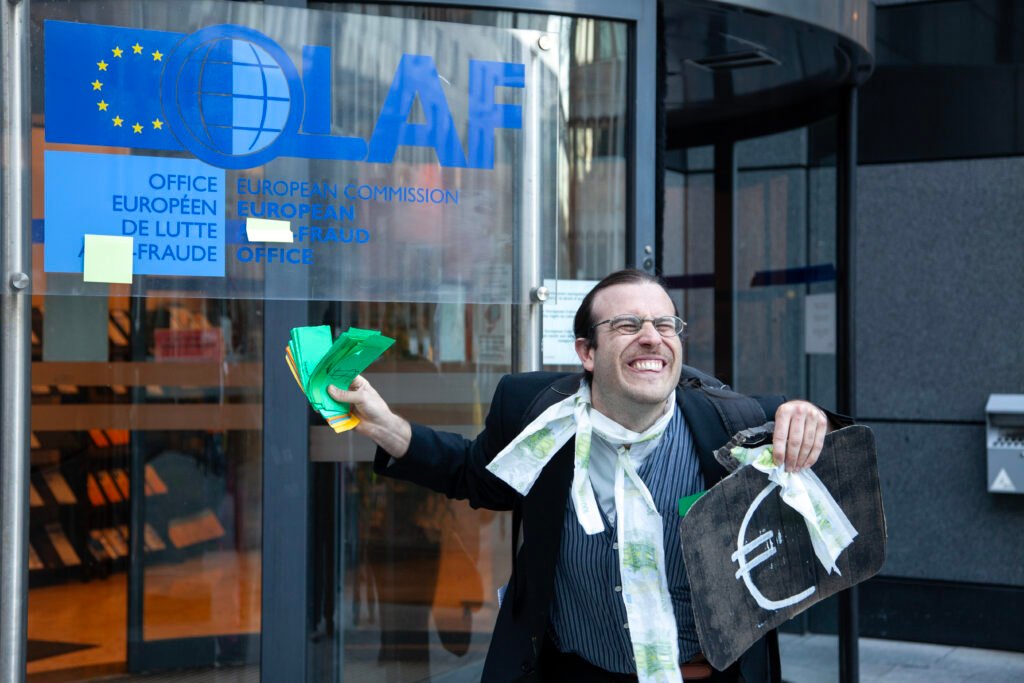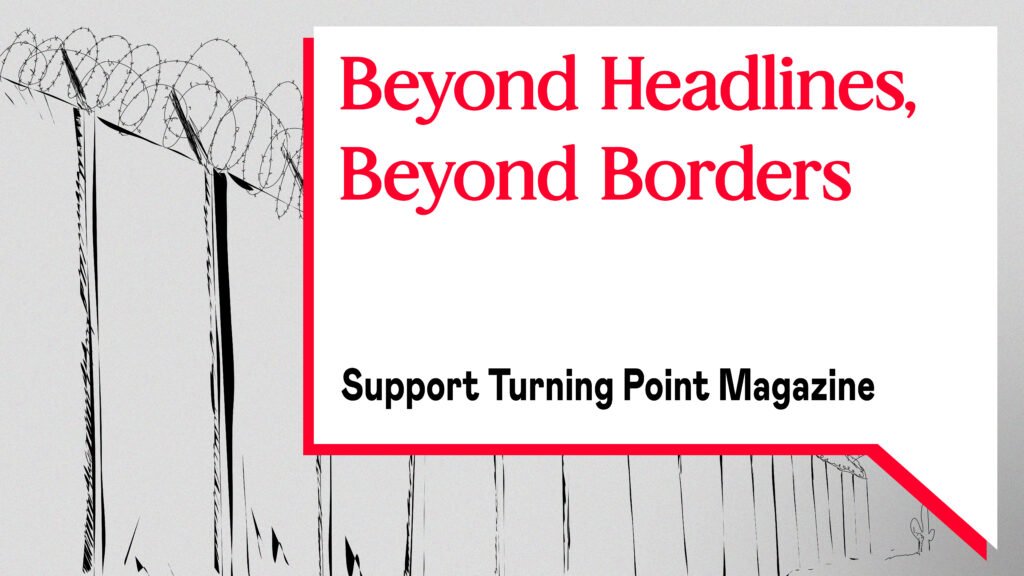Cover photo: Hellenthal, Am weißen Stein, Germany, August 22, 2022: In the silent whispers of the Zugvögel Festival, @loco_vision’s ‘Re’ installation casts a spellbinding net of reflections, where every gaze is captured and echoed back through time and light. © Ezekiel Angeloni
In an era where digital transformation is reshaping every aspect of our lives, the realm of money and payment networks is no exception. But what is at stake in the gradual yet significant shift from physical cash to digital forms of money?
Cash has always had unique attributes that have long made it a preferred medium of exchange: privacy, self-custody, and a sense of independence. But all that is changing as governments are increasingly pushing for a digital financial system, limiting the use of cash, and paving the way for Central Bank Digital Currencies (CBDCs). At the same time, other innovations try to keep control and privacy in users’ hands: decentralized cryptocurrencies, such as Bitcoin and Monero.
A future without cash may bring a shift that impacts whole societies, not just our wallets. Add to that the convenience of electronic payment methods, and we can understand why this digital transformation of payment systems might be successful.
The Unique Appeal of Cash: Privacy, Self-Custody, Independence, and Fungibility
Cash is a bearer instrument. Its owner can exchange it for goods and services without third-party involvement, and the transaction is private as no one besides the exchanging partners knows about it. The owner of cash is also its custodian: they do not need a bank or a third-party institution to hold it, but only a wallet for paper bills and coins. Another important aspect of cash is its fungibility: any 100-dollar bill, if genuine, is the same as any other 100-dollar bill. Finally, cash is independent and permissionless, at least in individual interactions.
Let’s put this in contrast with digital money – digital dollars in this case. A digital transaction is not private, as third parties are always involved: banks, credit card companies, or other participants in payment networks, such as Apple and Google. Usually, there is no self-custody, but companies or institutions hold your money and promise to pay you on demand. And you are not independent, as frozen bank accounts or simple payment network outages demonstrate.
Finally, digital fiat money is not fungible. There are source of funds investigations, money laundering rules, and other protocols that prevent you from using digital money unless you can prove where it comes from and the transaction’s purpose and nature.
Government Limits on Cash: The Push Towards Digital
The governments are issuing cash, but they are fighting it at the same time. Besides governments, international non-governmental institutions coordinate the fight against cash under the pretense of fighting tax evasion, terrorist financing, and money laundering.
It is essential to understand that most of the regulations are not laws passed by parliaments or even executive orders by executive branches of government. They are issued by non-governmental bodies such as the Financial Action Task Force (on Money Laundering) (FATF) or the Organization for Economic Co-operation and Development (OECD) and enforced by private payment networks.
We can notice this in payment infrastructures where more significant amounts are transferable only with “documentation” that proves the source of funds and the purpose of the transaction. A large bank can freeze your account and inform you that “we can send, receive, or route money to or from your bank if you can prove that you comply with FATF-GAFI ‘recommendations.’” It often means documenting how the transaction is taxed and how the sender got the money in the first place. Governments naturally enjoy this regulatory expansion as it improves their surveillance capabilities and control. And governments are predominantly about control.

At this point, some people would say “never mind, I will just send the money in cash in a suitcase.” However, this approach has many problems, as people might know if they ever actually tried to send money around in suitcases. If the transfer is across borders, the usual limit for transferring physical cash is $10,000. This limit has stayed the same since its introduction in 1970. However, the purchasing power of 10,000 US dollars in 1970 was more than $77,000 in current value according to the official consumer price index. Institutions have adopted this limit worldwide, but the limit is practically decreasing as the dollar loses value.
Many countries, especially in the European Union (EU), have introduced limits for cash transactions. It used to be possible to buy real estate with a suitcase of cash. In many countries, this is now illegal. In countries such as France, the limits are so low that cash becomes unusable for anything but necessities. The French limit on cash transactions is €1,000 for residents and €15,000 for non-residents. For more information on cash limits, see the Financial Tyranny Index by the Vexl Foundation. For residents, any transaction above €1,000 requires a non-cash payment method such as a credit card or a bank transfer. The euro is also losing value to inflation, so in a few years, the purchasing power of those €1,000 will decrease significantly.
Even in the United States, regulations impose restrictions on the use of cash. For instance, when dealing with financial institutions, any cash transaction exceeding $10,000 must be reported on FinCEN Form 104 (Currency Transaction Report). For this reason, bank tellers often consult their supervisors for large cash withdrawals, such as those amounting to $10,000.
Trying to circumvent these limits by splitting the transaction into smaller amounts is ineffective and potentially more problematic. This practice, known as “structuring,” involves executing two or more related cash transactions totaling $10,000 or more. Structuring is considered a criminal offense. Furthermore, adhering to transactions below $10,000 does not entirely circumvent scrutiny. The U.S. banks must also report any transactions they deem “suspicious” on the Treasury Department Form 90-22.47 (Suspicious Activity Report).
Digital Money and Surveillance
To comprehend financial surveillance, it’s essential first to grasp the broader concept of surveillance and how it differs from the 20th-century model dominated by physical spying methods. In their book The New Age of Intelligence, Paul Rosenberg and Jonathan Logan illustrate the shift from traditional surveillance to a more overarching, ruler-like perspective, offering a bird’s-eye view of societal activities:
“…viewing the city from above is very different from seeing it from the inside. And this is the view that intelligence takes; it’s the ruler’s view rather than the peasant’s view. And, truth be told, it can be an intoxicating view. “Drunk on power” is more than just a turn of phrase.”
The regulators often use the need for security against threats like terrorism and human trafficking to justify the push for mass surveillance. However, this approach poses the question as a tradeoff that expects individuals to sacrifice privacy. The reality, as described by Robert Anton Wilson, is a paradoxical scenario where creating an extensive secret police network meant to ensure national security ends up threatening the citizens it is supposed to protect. A surveillance approach creates a situation where everyone becomes a potential spy, making society more threatened by its surveillance apparatus than by external dangers.
“…to have national security, one must create a secret police. Since internal revolutionaries and external foes would make the secret police a prime target for infiltration, and because the secret police would by necessity have vast powers to blackmail and intimidate other members of the government, another higher set of secret police must be created to monitor the secret police. And an even higher set of secret police must then be created to monitor the higher order of secret police. Repeat ad nauseam.
This seemingly infinite regress goes on until every person in the country is spying on another, or until “the funding runs out.” And since this paranoid and self-monitoring situation inherently makes targets of a nation’s own citizens, the average person in the nation is more threatened by the massive secret police complex than by whatever foe they were seeking to protect themselves from.” – Celine’s Laws (Wikipedia)
Even people who trust their government right now admit that should the government become less tolerant towards freedom and justice, the mass surveillance apparatus is a much larger problem than guns in the hands of apparatchiks. One can easily go to bed in a liberal democracy and wake up the next day in a dictatorship that could easily re-purpose the technologies of mass surveillance for oppressive and unjust goals.

The Panopticon
We are finding ourselves in a panopticon – a prison design conceptualized by Jeremy Bentham, featuring a circular structure with a central observation tower allowing all inmates to be monitored by a single guard without them knowing whether they are watched at any given moment. If we think we are in a modern society-wide panopticon, we expect we could be watched at all times, and thus, we change our behavior. Of course, when that means our behavior is changing for the better, many people might argue this is good. But as with anything, there is a flip side. In this case, one might end up “bribing the guards,” thus increasing corruption. One might turn into a more covert mode of operation hidden from plain sight. Surveillance effectively creates polarization between mainstream society and a parallel society. It may also be called the second realm, the grey economy, the shadow economy, or – as Lunarpunks call it – the dark forest.
The panopticon effect, or the feeling that everyone is being watched, further increases social polarization. Some philosophers of freedom, such as Václav Benda, say that parallel societies are only possible when the first realm – mainstream society – is free enough. In reality, parallel societies thrive especially when the primary society is repressive. However, thanks to the panopticon effect, they hide themselves from mainstream society even more than they otherwise would.
This polarization also changes the modus operandi of violent criminal groups. If they know they are operating in a panopticon, they use advanced encryption technologies and covert meeting spaces, bribe bankers to launder money, and use cash. Criminal groups adapt easily. Some people will specialize in providing services that allow these groups to hide their activities even better.
Here, the panopticon effect creates a peculiar negative effect. Many inhabitants of mainstream society slowly spend more of their time in the second realm just because they feel uncomfortable being watched. They fear they might break some rules they don’t even know about or did not consider. Often, they become outlaws. The real violent criminals adapt and go into a “full dark” mode of operation. They are not willing to risk any exposure. Every interaction or monetary transaction is a bit more expensive but also untraceable. They bribe people to have a shield against the members of the first realm. Finally, when bribes stop working, more violent behavior occurs, such as murders of journalists or other people who can expose or prosecute these violent criminals.
In a panopticon, things seem to be more civil. Everyone is watched, so everyone ensures that the overseers do not see any bad behavior. Honest people start hiding. Society looks less dangerous and less criminal while the number of actions against the law actually increases.
Mass Surveillance vs. Targeted Surveillance
There is a distinction between mass surveillance and targeted surveillance in the financial sector. Once, an executive in a bank in Slovakia told me a story of his bank’s compliance department’s interaction with the financial police. Their system for detecting suspicious transactions produced only a few flagged transactions. The financial police complained that they were not sending them suspicious transactions, as if there was a quota. The bank then decided to send them all transactions above a specific value. They immediately got a call from the financial police that they did not wish to be spammed with so many transactions because they had no staff to investigate them. The bank then asked how many suspicious transactions they would like, and they agreed on an average number that other banks tend to send.
Financial police usually receive targeted and specific information. In most Western countries, they do not have access to mass surveillance data. On the other hand, your transaction might be reported even though you are not doing anything suspicious because the banks need to fill their reporting quota somehow. We can see that there are rarely probable causes for investigation because financial police and anti-money laundering regulations are only one piece of the financial surveillance puzzle. At this point, mass surveillance comes in, usually disguised as a fight against tax evasion.
There is more to data than what the surveillance agencies see directly. Paying $100 with my credit or debit card every Wednesday might mean I am on a date with my wife in our favorite restaurant. It is unlikely that I would eat food worth $100 in that particular restaurant alone. Also, I never pay in bars, so it is very unlikely that the $100 is for dinner and cocktails. If my wife makes a purchase in a shopping mall across the town, the information changes: I might be having dinner with a lover.
When I donate to a libertarian think-tank or support the Tor project, it tells anyone who sees the transaction about my political views and opinions on privacy. If my credit card bill is consistently over $5000 and I pay it all monthly, it tells my income level to the credit card company, the bank, and everyone else who sees the transactions. But it is not only the credit card company – this information will end up in a credit registry that all banks can access.
These few paragraphs show that derived data tell us much more about us than “there was a $100 debit from the bank account on Wednesday evening.” Also, most of the derived data is not actually analyzed by humans. The invention of machine learning and the possibility of applying it to huge datasets which contain all the information available have automated the use of derived data.
Most people think machine learning – often used synonymously with the broader term artificial intelligence – is about logic and inference. That is not how most machine learning algorithms work, although logic and inference are certainly doable with computers, as seen in the Wednesday dinner case. The derived data that appears as a result of machine learning on big data is much more precise and detailed.
Machine learning and big data are more like “machine intuition.” One of the properties of intuition is that we often know the answer, but we don’t know why we arrived at a certain conclusion. Imagine walking on a mountain. Suddenly, you stop and start feeling anxious. You look around, become quiet, and start listening more carefully. You are evaluating possible threats. Your body starts preparing to run or fight. The level of adrenaline rises. Then, you might conclude that it was just a remote sound that your pattern recognition neural network interpreted as a possible crack of a large animal walking towards you.
The similarity of this process with big data and machine learning is striking. I call it machine intuition because “artificial intelligence” evokes an image of a logical thinking process. Machine learning works on big data similarly to intuition in the previous paragraph. It processes all the available sensory data and seeks patterns. Then, by association or supervised learning, it identifies and labels the patterns in the data. My dinner might be labeled as a dinner with my wife, but it is not a straightforward logical process, as in the case of deduction from facts.
A mass surveillance algorithm arrives at a certain conclusion because it has recognized a pattern in the thousands of other credit card users who pay this amount in this area: they had typically gone to dinner if their wives were not using their credit cards simultaneously. This conclusion is probabilistic or post-rational, not logical or necessarily even factual. The patterns are everything that a machine learning algorithm sees.
Like human intuition, machine intuition is prone to errors. It does not explain the reason for a particular result but only hints at something. This is why this approach will have false positives – “suspicious-looking” behavior that is not really suspicious or criminal – and false negatives.

Surveillance Capitalism
If you use an app or visit a website, it usually initiates hundreds of “sparks.” Each spark represents the activity of selling your characterizing information to the advertisement bidders at the auction to show you an advert before video or other website content. The algorithm then updates your profile based on your reaction to the advertisement. Single websites or apps can follow you all around the internet through a technique called retargeting. An advertisement for a product you are just considering is not a coincidence. It’s a result of machine intuition.
There is no single entity behind this, although there are big players. We do not know precisely what is happening and who the actors are because the market structure behind this is very complex and mostly invisible to the surveilled person. The surveillance capitalism landscape is complex and interconnected and does not follow any written central plan like state surveillance. But we know why it’s happening: giving away stuff for free is not a business strategy that would be sustainable for companies, and they need to find funding somewhere. Learn more about surveillance capitalism in Wolfie Christl’s Corporate Surveillance in Everyday Life.
State agencies are not the only actors in the financial surveillance and surveillance business. In fact, state agencies outsource many aspects of surveillance to private entities – either knowingly, voluntarily, and directly (analysts and big data companies such as Palantir), as a part of regulations and licensing schemes (banks, financial institutions), as a part of a product they are providing (advertisers, social networks), or unknowingly, as a side effect of their business (for example some loyalty programs).
Private entities, not governments, power surveillance capitalism, although states also play a role. The inner workings of this form of surveillance are hard to grasp, as parliaments or other central bodies do not articulate these regulations.
We can grasp something, at least. For example, PayPal shares personal information with more than 600 third parties, including other payment providers, credit reporting agencies, identity verification and fraud detection companies, and other most advanced players in the online tracking ecosystem, such as marketing agencies. A risk management system of a credit card company needs to know if you are on vacation in Thailand or at home to confirm or reject your purchase of a ticket from a Thai train company’s ticket machine in Bangkok.
Push Towards Anti-Money Laundering and Government-Mandated Surveillance
The Financial Action Task Force (on Money Laundering) (FATF), also known by its French name, Groupe d’action financière (GAFI), is an intergovernmental organization founded in 1989 on the initiative of the G7 to develop policies to combat money laundering. In 2001, its mandate expanded to include terrorism financing. It monitors progress in implementing the FATF Recommendations through “peer reviews” or “mutual evaluations” of member countries. The FATF Secretariat is housed at the OECD headquarters in Paris.
The FATF is one of the most successful non-democratic regulatory bodies in the world. Their “recommendations” are enforced as laws to combat money laundering. Yet, the results are a spectacular failure. Anti-money-laundering (AML) triggers have discovered about $3 billion of laundered assets out of the estimated total of $3 trillion. So, they are 0.1% effective.
According to a study by Ronald F. Pol, this policy costs $300 billion in compliance costs and an additional $8 billion in business costs. This point is worth repeating: we pay $100 for every dollar discovered in money laundering. And for every dollar discovered and recovered, 999 dollars have not been discovered. This has to be the most spectacular policy failure, robbing us of prosperity. FATF has been doing this for decades, yet there are only more regulations, more forms to fill, and more compliance costs. But these new regulations do not decrease money laundering – they just make the money go around these regulations in novel ways.
The Rise of Central Bank Digital Currencies (CBDCs)
The final blow to money laundering would be the introduction of Central Bank Digital Currencies and a complete removal of cash at some point. The PR machines of central banks already promote the notion of cash being a barbaric relic of the past. They say we need to focus our attention on the future, and the future is digital.
In a fully digitized economy, the banks could see everything with the push of a button. The central bankers promise privacy, but there are caveats. Most notably, the central bank and government authorities see everything – there would be no privacy from the state.
In a fully digitized economy, the banks could see everything with the push of a button. The central bankers promise privacy, but there are caveats. Most notably, the central bank and government authorities see everything – there would be no privacy from the state. So, it would not actually increase privacy, especially not compared to cash transactions that the state does not see by default.
The second problem is that states are particularly bad at protecting private information. Leaks of healthcare data, tax returns, and even the most private information that can be used for phishing and identity theft are common. There have been massive leaks of COVID-19 vaccination information (for example, in Slovakia), citizens’ names and dates of birth, and many other private data. Centralizing this private information makes each leak much worse. When banks are hacked, their customers are affected. When CBDCs are hacked, every citizen is affected.
CBDCs bring about the Chinese-style top-down control of citizens with a full-on panopticon effect. Any sane citizen should refuse to use this system for their sanity.
But What If Cash Is Banned? CBDCs vs. Cryptocurrencies
The value of fiat money is tied to a government mandate. If the state declares the bills and coins invalid, there’s really no point in continuing to use them. If a monetary reform phases out cash, its value will be cut to the value of printing paper.
Thankfully, we have alternatives. Gold and silver coins have a value tied to the coin’s precious metal content. Cryptocurrencies such as Bitcoin and Monero are a new form of digital scarcity with many cash-like properties. The title of Satoshi Nakomoto’s white paper, which introduced the first decentralized peer-to-peer currency, is “Bitcoin: A peer-to-peer electronic cash system.” And it delivered. Bitcoin developed into a peer-to-peer, permissionless digital currency, meaning that no third parties are involved in the transactions. While being digital, Bitcoin has cash-like properties. It is primarily a hard-money system, providing a value-anchor to more evolved payment systems such as the Lightning Network, which brings fungibility, faster and cheaper payments, and even innovations like speedy payments. It combines the best of physical cash and digital money with additional protection against inflation, which occurs when central bankers can print more money by pushing a button.
Other payment networks and currencies with different properties have been invented, too. One notable project is Monero, which is private by default. When the end of cash is near, these projects will allow us to keep our privacy and transfer us to the digital age under our terms.
What if governments ban them? Because governments do not issue them, their value does not come from government mandates. They are valuable by themselves and can be exchanged for goods and services. And there are market structures that allow us to use them even in the harshest regulatory environments – with proxy merchants, “off-the-counter” dealers, and other market actors helping us exchange these currencies for things we want to purchase.
Conclusion
While surveillance systems are scary and central bankers are tightening their control of monetary systems, there is always demand to escape the panopticon. Parallel economies, hard money enthusiasts, and privacy extremists all require cash-like payment systems and money. We have everything we need.
My suggestion to everyone is this – give it a try. I am not saying invest, but experience cryptocurrencies, know how to send and receive them, and understand how they work. It is a very useful skill.
And then, when you understand, you might want to… well, I’ll quote Satoshi Nakamoto: “It might make sense just to get some in case it catches on. If enough people think the same way, that becomes a self-fulfilling prophecy.”

Juraj Bednar
Juraj is an educator, book author, coder, cryptoanarchist. He helps people turn off statism in their own heads and disconnect their brains from the hierarchies of the world. He is a co-founder of Paralelní Polis and author of the book Cryptocurrencies – Hack Your Way to a Better Life. Enjoyer of volatility, swimmer in uncertainty.




